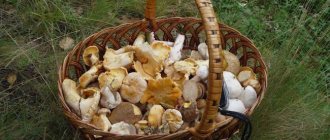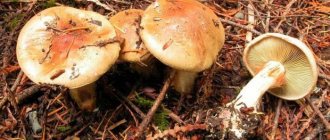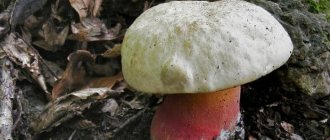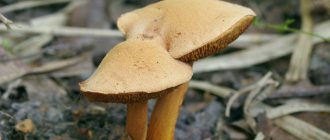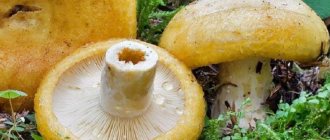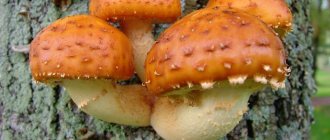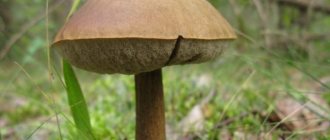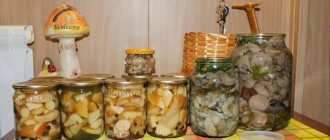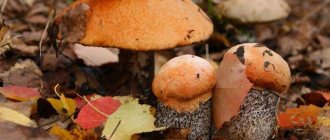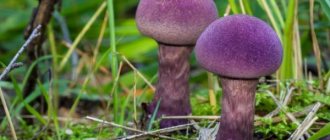Mushrooms add variety to the diet and bring pleasure to many people because they are healthy and tasty. They are rich in vitamins, proteins and carbohydrates; young specimens contain many microelements necessary for the body: iodine, iron, zinc, calcium. A beautifully prepared mushroom dish improves metabolism, activates the gastrointestinal tract (gastrointestinal tract) and nervous system. Many people love “silent hunting,” but not everyone knows how to distinguish an edible mushroom from an inedible one.
Types of mushrooms
Mushrooms are divided into:
- edible;
- inedible;
- conditionally edible.
Edible mushrooms, photo and name, and description, of course, will help you decide when identifying a valuable food product rich in proteins and vitamins, minerals and aromatics. The number of edible mushrooms reaches 500 species, but no more than 100 species are known to a wide circle, and no more than 10-15 are known to most mushroom pickers. Great lovers and connoisseurs of mushrooms will always help a beginner understand their findings, but one should not trust them completely; mistakes are human.
How not to confuse the porcini mushroom.
Therefore, by carefully looking at the photo and remembering exactly what the most common and valuable mushrooms look like, you can easily and independently decide on the edibility of a mushroom.
Unusual mushrooms of the world: names
Despite the fact that Russia is truly a mushroom country, very unusual specimens can be found not only here, but throughout the world.
We offer you several options for unusual edible and poisonous varieties with photos and names (Figure 8):
- Blue is a bright azure color. Found in India and New Zealand. Despite the fact that its toxicity has been little studied, it is not recommended to eat it.
- Bleeding Tooth is a very bitter variety that is theoretically edible, but its unattractive appearance and poor taste make it unsuitable for consumption. Found in North America, Iran, Korea and some European countries.
- Bird's Nest is an unusual New Zealand variety that actually resembles a bird's nest in shape. Inside the fruiting body there are spores that spread around under the influence of rainwater.
- Comb blackberry is also found in Russia. Its taste is similar to shrimp meat, and its appearance resembles a shaggy heap. Unfortunately, it is rare and is listed in the Red Book, so it is grown mainly artificially.
- The giant golovach is a distant relative of the champignon. It is also edible, but only young specimens with white flesh. Found everywhere in deciduous forests, fields and meadows.
- The devil's cigar is not only a very beautiful variety, but also a rare variety that is found only in Texas and a few regions of Japan.
Figure 8. The most unusual mushrooms in the world: 1 - blue, 2 - bleeding tooth, 3 - bird's nest, 4 - combed blackberry, 5 - giant bighead, 6 - devil's cigar Another
unusual representative is considered to be the brain trembler, which is found mainly in temperate climates . You cannot eat it, as it is deadly poisonous. We have provided a far from complete list of unusual varieties, since specimens of strange shape and color are found all over the world. Unfortunately, most of them are inedible.
What are poisonous mushrooms
Dangerous poisonous mushrooms are distinguished by the presence of toxins, and known poisonous components are represented by three main groups:
- The first group includes local toxins that can cause various disorders in the digestive system. This category includes species represented by russula, satanic mushroom, undercooked autumn honey mushrooms, variegated and yellow-skinned champignon, false puffball and tiger row. In rare cases, death may occur;
- The second group includes neurotropic toxins that have a pronounced effect on the human nervous system. The first symptoms of poisoning appear after about half an hour and can include hallucinations, loss of consciousness and severe indigestion. The group includes fly agarics, some types of fibers, talkers, rows, Russula vomitus, some hebeloms and entoloms;
- The third group includes toxins that have a pronounced plasmatoxic effect. This group of poisonous mushrooms includes stitches and many lobes, fringed galerina, and orange-red cobweb.
If the mushroom is highly poisonous, then even timely treatment cannot guarantee complete safety.
Interesting read: Red trellis: all about the unusual mushroom.
Why you can’t destroy poisonous mushrooms
The destruction of fungi can cause significant harm to the ecosystem and upset the natural balance. Many spongy and lamellar species that are poisonous to humans are used for medicinal purposes by some large artiodactyls. Also, poisonous varieties find purely practical use. Medicines and healing agents based on them can cure rheumatism, various nervous disorders, lung diseases and oncology, as well as many other pathologies.
Poisonous mushrooms.
Is it possible to test mushrooms for edibility using folk remedies?
Determining "mushroom poison" using homemade products is a dangerous myth. How to test mushrooms without knowing either the composition of the poisons or the substances that react to them? “Tested products” detect completely different substances.
- Testing with onions, vinegar, and milk, which they try to use as indicators of toxins, actually shows the presence of enzymes such as tyrosinase (it turns onions dark), pepsin (milk curdles). These enzymes are found in many foods, which does not mean they are unsuitable for food.
- Silver items immersed in water with mushrooms darken from amino acids containing sulfur - this is also not poison. There are many of them in meat, fish, seeds - protein-rich foods.
- But substances that cause poisoning cannot be brought to clean water using improvised means. Currently, an “indicator ticket” has been patented that identifies the toxin of the toadstool and the entire deadly Amish genus, but its mass use has not yet been heard.
We recommend: “Guests on the doorstep”: 9 recipes that can be prepared quickly
General differences between edible and inedible mushrooms
Sometimes poisoning occurs due to one piece of toadstool or red fly agaric that gets on the table along with edible mushrooms. In order not to confuse edible and inedible mushrooms, it is necessary to accurately understand which specimens are common in the area and what they look like. Only the mushroom that is well known is placed in the basket. Some varieties of edible and inedible crops are similar to each other. Despite the similarities, they also have a number of differences.
- Appearance: the color of edible specimens is often dull, but there are exceptions. For example, the chicken mushroom has a bright yellow cap. The poison in inedible organisms repels insects. Edible specimens most often contain a lot of worms and beetles. Edible varieties also have a skirt. Most poisonous ones do not have it.
- Discoloration at the break (cut): edible and poisonous mushrooms are characterized by this feature. In edible specimens it becomes beige or brown, while in poisonous specimens it acquires a brighter color (red, orange), or the dangerous mushroom turns blue.
- Smell: This is often what determines edibility. Almost all edible mushrooms have a pleasant aroma. Parasitic mushrooms and specimens not suitable for food have a chlorine or medicinal odor, but there are exceptions (fly agaric).
- Cap surface: Many inedible varieties have a sticky cap that feels sticky to the touch. It is also worth avoiding those specimens that do not have a tubular layer under the cap.
- Base of the leg: in poisonous specimens, the base of the leg is almost always immersed (surrounded) by a special sac (volva) - a remnant of the common veil. Edible mushrooms do not have such a formation. Also, in inedible and poisonous specimens, in addition to the volva, the base of the stalk is expanded into a tuber-like well-defined formation.
These are the main differences between edible and inedible mushrooms. Of the poisonous species in Russia, the most common are the pale toadstool (green fly agaric), red fly agaric, thin pig and satanic mushroom. The pale grebe is deadly. If the above signs are absent, but you are not sure that the specimen found does not contain toxic substances, you should not take it.
Fly agaric.
Tips for beginner mushroom pickers
If possible, it is best for beginners to go into the forest in the company of experienced mushroom pickers. If you have the slightest doubt, a specialist will always answer your questions and also help you distinguish between edible and poisonous fruits based on their characteristic features.
Properly selected clothing plays an important role in safety during a “silent hunt.” It should be loose, but at the same time reliably protect the body from insects. Shoes must be closed. Neither flip-flops nor sandals are suitable in this case. You also need to put a cap, hat or scarf on your head.
For collecting fruits, the best option is a basket made of pine shingles, birch bark or wicker. Plastic buckets or plastic bags will not work, especially if the mushroom picker’s target is red caps, butter mushrooms or boletus mushrooms.
Advice!
It is a mistaken belief that the further a person goes into the forest, the greater the harvest will be. In fact, you need to look for fruits on the edges, in ravines, along forest paths and forest belts. And many edible mushrooms grow in parks or gardens.
It is strictly not recommended to harvest mushrooms in places located within a radius of 0.5-1 km from roads or busy highways. Fruits have one peculiarity: they accumulate harmful substances, toxins and heavy metals. These elements are not completely neutralized during cooking, frying, or other types of cooking.
Myths and folk signs about mushrooms
Many mushroom lovers have to be content with only purchased ones, since not everyone knows how to identify poisonous specimens and distinguish them from edible ones. Of course, banal logic will not allow you to cut off an acid-green specimen into a lilac speck, but many poisonous species look like they are quite edible.
Moreover, there are a lot of misconceptions about how to test mushrooms for toxicity. To refute most of them, experts say that there are no simple ways to determine the toxicity of a mushroom. Many species react differently to the same techniques, and it is very easy to become poisoned by a seemingly edible product.
A young mushroom does not mean it is edible
It is believed that all mushrooms can be eaten while they are young. It is implied that the poison in them appears only over time. This is also an absurd fallacy. For example, the pale grebe is poisonous at any age. It is best to study the mushroom encyclopedia and know the edible species by sight. If you have the slightest doubt about the suitability of a foundling as food, you should throw it away. This is not a case where the risk can be justified.
Phalloidin is one of the most dangerous mushroom poisons. Most of all it is contained in the pale toadstool. In terms of its adverse effects on the human body, phalloidin is equivalent to snake venom. An adult toadstool contains 10 mg of this substance, and when a person consumes 20 mg, 98% of cases result in death.
Will silver help?
There is a misconception: if you put a silver object in water during cooking, it will turn black, indicating that among the products there are poisonous ones. Amino acids that contain sulfur cause blackening of silver. But this substance is present not only in poisonous, but also in edible species. There is even a separate subspecies of poisonous mushrooms that this method will not detect. It follows from this that this method is not at all valuable.
How to determine if a mushroom is edible.
Onion and garlic
While cooking the mushrooms, add onion or garlic to the water. If there are poisonous mushrooms in the container, the heads of the root crops will turn black. It is useless to check the toxicity of mushrooms with onions or garlic during cooking. The color change of onion or garlic to brown during cooking occurs due to the pigment tyrosinase. It is found in both poisonous and edible mushrooms.
Boiling
If you boil fresh mushrooms for several hours, they will lose all their toxicity. Unfortunately, this is not the case - most of the poisons in mushrooms are heat-resistant and are not afraid of heat treatment.
How to pick mushrooms correctly.
sour milk
If you place mushrooms in fresh homemade milk for a while, it will turn sour. Enzymes such as pepsin and organic acids contribute to the sourness of milk. These enzymes are found in edible, inedible and poisonous mushrooms.
Bad smell
Poisonous mushrooms have a strong, unpleasant odor. Odor is an integral part of any mushroom. Only novice mushroom pickers will believe that poisonous mushrooms have a specific vile odor, while edible ones smell acceptable. This argument is not worth a penny. For example, champignon smells exactly the same as the terribly poisonous toadstool. In addition, not all people have a keen sense of smell and are generally able to distinguish the subtleties of mushroom aromas.
Pests
Worms, insects and snails do not eat poisonous mushrooms. If there are traces on the mushroom indicating that some small forest dweller has already feasted on it, then it is edible. This is another tale that circulates among beginners. Larvae, insects, snails and other small animals can spoil the poisonous mushroom with their appetite. Chanterelles and Polish mushrooms remain untouchable.
Alcohol is not a cure for poison
This is one of the most dangerous misconceptions. A high-proof drink will not help, but will greatly aggravate the condition of the person who has eaten poisonous mushrooms. Alcohol-containing substances provoke an accelerated spread of toxic substances throughout the human body, and therefore only accelerate the effect of the poison.
How not to get poisoned by mushrooms.
Pleasant taste
If a mushroom is tasty, it is not poisonous. Many mushroom pickers try raw mushrooms when picking. If it tastes bitter, it is poisonous. It is believed that the minimum amount of poison that enters the body with saliva during tasting will not cause significant harm. Reality: there are clearly poisonous mushrooms without bitterness with a very pleasant taste:
- death cap;
- poisonous entoloma;
- red and panther fly agarics;
- many other types.
Pink records
Pink plates under the cap of the mushroom indicate its edibility. Reality: indeed, young champignons also have pink plates, just like poisonous mushrooms, so this is far from an indicator.
Pink plates of mushroom.
Terrain
Poisonous mushrooms do not grow in open areas, but only in forests. Reality: A completely unfounded misconception. There are numerous cases of poisoning from mushrooms collected in meadows.
Fault color
When the cap is broken, the blue, pink or reddened flesh symbolizes the unfavorability of the find. White, gray, beige and other shades that have not reacted to the oxygen of the pulp indicate edibility. At the break, many edible species turn blue or change color.
There are certain varieties of mushrooms that are partially unsuitable. They need to be boiled for a long time in a special mixture of vinegar and salt, and then when fried they will be completely edible. But this method does not apply to all unfavorable samples.
Cooking check
An equally popular method for determining toxicity when cooking mushrooms. In this case, it is assumed to use any silver object, a silver spoon, which must be dipped into the mushroom broth. In the presence of poisonous mushrooms, silver is expected to turn black. This common myth has long been debunked: silver will certainly darken under the influence of amino acids, which contain sulfur and can be part of the pulp of not only poisonous, but also completely edible mushrooms. Among other things, there are many known poisonous mushrooms that lack sulfur-containing amino acids.
Poisonous mushrooms in Russian forests
The mortality rate from poisoning with poisonous mushrooms reaches 90% in some cases! Poisonous mushrooms are especially dangerous for children. The main distinguishing feature of poisonous mushrooms is the presence of deadly substances in them, and not external similarity or the absence of any “normal” mushroom characteristic. Therefore, when going on a mushroom hunt, it is important to become thoroughly familiar with the representatives of poisonous mushrooms.
Poisonous mushrooms of Russia.
Death cap
Pale toadstool is perhaps the most poisonous mushroom! It is better to avoid poisoning with toadstool! The appearance of this mushroom is practically not much different from other mushrooms growing in forests, so it can easily be confused with an edible mushroom. The color of the cap of this toadstool is yellowish-brown, pale greenish or greenish-olive. Usually the center of the cap is darker in color than its edges.
The structure of this type of mushroom is quite fleshy, with cylindrical stripes of pale green color. On top of the leg there is a ring of striped pale or white color. Pale grebe (photo) forms mycorrhiza on deciduous trees, growing in mixed and deciduous forests. It begins to bear fruit at the end of summer to the end of September. Toadstool (pictures) is highly toxic.
Death cap.
False honey agaric
The mushroom has a convex cap up to 5 cm in diameter. The color of the cap is predominantly yellowish with a red or orange tint and a darker color in the center. The mushroom has a thin, smooth, hollow, fibrous stem. The flesh of the mushroom is light yellow, has a bitter taste and an unpleasant odor. The false honey fungus lives from June to October. Most often it can be found in fairly large groups on rotting wood.
The mushroom is poisonous and causes digestive upset. After 1-6 hours, signs of poisoning immediately appear: vomiting, loss of consciousness, nausea, excessive sweating. The false honey fungus is similar in appearance to the autumn, winter, summer and gray-plate honey fungus.
False chanterelle (orange talker)
This poisonous mushroom has a brightly colored cap from orange-red to copper-red. The shape of the false chanterelle's cap resembles a funnel with a smooth edge. The plates of the mushroom are bright red, sinuous. The stalk is approximately 10 cm long and 10 mm wide, often narrowed towards the base. False chanterelles mainly grow in the warm season from July to October, near real chanterelles. Also, this type of mushroom often grows in families, in rare cases alone.
Hygrophoropsis aurantiaca.
The false chanterelle can be easily distinguished from the edible chanterelle: The real chanterelle has a bright yellow color, a concave cap, smooth on top and wavy at the edges. The leg is dense and elastic, slightly darker than the cap. A characteristic feature of chanterelles is their pleasant fruity aroma. False relatives of the chanterelle are brighter in appearance, yellow-orange in color, with a hollow and thin leg. The edges of her hat are smooth, unlike a real chanterelle. And most importantly: the pulp of the false chanterelle has a very unpleasant odor.
Bile mushroom
These mushrooms are sometimes quite similar in appearance to edible mushrooms, and the first on this list of masters of camouflage is the gall mushroom or bitterling. Even a couple of grams of this mushroom can spoil a barrel of pickled edible mushrooms; all of them, as if by magic, will become bitter. The gall mushroom is similar to the king of mushrooms - porcini or boletus, but what should immediately catch your eye is the pink surface of the tubular layer, atypical for these edible mushrooms, the pink flesh and the brown, and not white, mesh on the stalk, which is not typical for these edible mushrooms.
Gall mushroom.
Red champignon
The second place is rightfully occupied by the red champignon. It has most of the characteristics of an edible mushroom, however it is highly poisonous. External differences that should definitely catch your eye are the yellowing of the fungal tissue on the breaks and an unpleasant odor reminiscent of carbolic acid.
False foam
The sulfur-yellow false honey fungus is confidently in third place. This is one of the few types of inedible mushrooms. The mushroom can be quite easily distinguished by the color of the cap plates - at a young age they are sulfur-yellow, and over time they become greenish. The pulp of the mushroom itself has a bitter taste and should immediately raise suspicion.
False foam.
Fly agarics
The last place is occupied by mushrooms, which probably even a schoolboy can distinguish from edible ones - fly agarics. However, you should not think that fly agaric is always red. It can be white, as indicated above, and yellow, and green, and even brown. The cap of the fly agaric is spectacular, one might even say beautiful, it is covered with flakes characteristic only of this type of mushroom, and the leg below is noticeably widened and has a ring. The pulp of the mushroom smells so unpleasant that flies actually die from this smell.
Main characteristics of mushrooms
Scientists argued for a long time about milk mushrooms, boletuses and their relatives, not knowing where to classify them. They contain approximately the same amount of protein as animal food, and minerals and vitamins as in plants. Only in 1960 were they identified as a separate mushroom kingdom.
Accurate criteria for distinguishing good species from dangerous ones have not yet been developed. Fans of “silent hunting” rely on their own experience, which is passed on from generation to generation. In this case, the main rule must be strictly observed: do not take copies that raise even the slightest doubt. Otherwise, one small mushroom can ruin your whole life.
Characteristic criteria for edible species
The general features are very vague and averaged.
The main ones include:
- absence of a ring on the leg;
- tubular structure;
- the inner pulp of the fruiting bodies is light in color;
- the hat has catchy bright colors;
- absence of bitter taste and pungent odor.
These differences are conditional. For example, the pale grebe has a white tint on the break and has a weak smell, although it is poisonous. It is worth paying attention to the place of growth. Typically, false colonies are located away from areas where good mushrooms grow. To determine for sure whether a mushroom is edible or not, it is better to consider each of them separately.
This is what is most often found in mushroom pickers' baskets.
Boletus
One of the most popular types. Tough as a turnip. Tasty both boiled and fried. People call it “redhead” for its bright hat. The leg has characteristic black specks. If you cut it, it turns blue. It grows not only in aspen trees, but also under other deciduous trees. An aspen boletus grown in a clearing in the grass may have a pale scarlet or even colorless cap and a white leg without black specks. Young redheads have a spherical cap, pressed against the stem; as they grow, the head straightens and thickens. It practically does not grow in coniferous forests.
boletus
It has many subspecies, differing in color and taste. The shades of the cap range from light gray to dark brown. The leg is cylindrical with black scales. As it grows it becomes fibrous. The most delicious specimens grow at higher elevations. They are strong and resilient. The dark cap has light brown spots on the bottom. On the edges of swamps, watery specimens grow - moss mushrooms. In the basket, they are squeezed by other mushrooms and turn into shapeless mush. They are collected when there is nothing else. In terms of taste, boletus mushrooms are significantly inferior to aspen boletuses.
Polish mushroom (yellow mushroom, chestnut moss mushroom)
It has a yellow or brown top with a tubular structure and a leg of the same color, which is darker at the root. Turns blue when cut. Suitable for frying, soups, pickling. When dried, it acquires a pleasant yellow color. Not all mushroom pickers collect them when there is a harvest of more tasty species.
Kozlyak (sheeper)
It grows in colonies in meadows and deciduous-coniferous forests. Champion in worminess. Coloring ranges from light yellow to dark brown. Turns blue when cut. Some consider it inedible, others do not take it because of its low taste and unsightly appearance in soup. This is true. But in dried form, it can be compared with the legendary porcini mushroom, especially if young specimens are dried whole. At the same time, they do not turn black, maintaining their natural color. A delicacy for deer, that’s why goat is also called “deer mushroom.”
Ryzhik
It does not grow everywhere, but is considered the royal mushroom. Very nutritious and high in calories. The color of this forest gift also determined its name. Moreover, both the leg and the lamellar cap are red, on which there are sometimes greenish circles or dark gray spots on top. The pulp is also dark orange, changing to brown or greenish when cut. It grows mainly in spruce forests, hiding in old conifer needles that have fallen to the ground. Suitable for all types of processing except drying. Good for pickling.
Volnushka
One of the most sought after forest gifts. It often appears on tables in salted form. It has a light brown or beige stem and a reddish-red cap with characteristic rings. In young voles, mohra grows around the circumference of the top, the edges bend downwards. The pulp is dense. White milk appears on the cut. It is better to collect small specimens before the flesh becomes loose and wormy.
Common white breast
The king of lamellar mushrooms. Ideal for pickling, but you need to soak for a long time, several days. It’s especially tasty with trumpets. In this case, it does not stick together. The harvest does not occur every year. The optimal diameter of the cap for collecting is 5-7 cm. It likes to hide under fallen leaves due to its short white stem. In appearance it looks like a wave. The same moss, with curved edges at the beginning of growth, with brown rings on the cap, which is denser, but the color is white. Of the lamellar species, milk mushrooms are the strongest. White or yellowish milk appears on the cut. Loves moisture and pine needles. There is also a yellow mushroom (aspen). It turns purple when cut.
Russula
Universal look. As the name suggests, it is even suitable for consumption raw. It’s good in soup, fried with potatoes, pickled, and salted. Not suitable for drying. Many people do not like russula, considering them second-class mushrooms. This is wrong. There are mushroom pickers who collect only this species, which is distinguished by a variety of colors: red, orange, purple, gray-green. The leg is white. The cap is plate-shaped. The only negative is that it crumbles a lot, which not everyone likes. The strongest are young specimens of orange or greenish color. Their head is semicircular and dense.
Walui (kubari)
In terms of taste, it is close to milk mushrooms. Grows selectively. Young specimens have a ball-shaped cap. Its color ranges from beige to dark brown. Good for pickling.
Raincoat
It has many names: hare potato, gypsy powder, wolf tobacco. Only young fruiting bodies in the shape of a needle-shaped white ball with dense pulp are used for food. When ripe, the spores darken and turn into dust, and the mushroom itself transforms into a dark brown or black sac. If you step on the shell, it contracts and a column of dust appears in the air.
Signs of toadstools
The most important criterion by which poisonous mushrooms can be identified is the structure of the cap. If it is tubular, you can safely put the find in the basket. There are no mortal dangers among them, and if the trophies are subjected to heat treatment, then there is no need to be afraid at all.
In addition to the main one, you should pay attention to other signs characteristic of dangerous finds:
- skirt (ring) near the hat;
- thickening (vulva) on the pedicle in the root area;
- the flesh on the break turns red;
- unpleasant strong odor.
Toadstools common in Russia
There are not so many dangerous mushrooms in the world. But it is unlikely that Russians will be interested in reading about the deadly “angel of death” from the fly agaric family, growing in North America. But about dangerous finds that can end up in a mushroom picker’s basket in our country, information will not be superfluous. There are only a few deadly species among them, but there is no need for serious stomach upset either. He who is forewarned is forearmed.
Omphalote olive
It grows, for the most part, in Crimea, and now it is ours. It is found on rotten trunks of deciduous trees and rotten stumps. It looks like a chanterelle, but it has a nasty smell - a sign of the presence of the toxic substance illudin S, which can cause severe pain, attacks of diarrhea and vomiting.
Foliotina wrinkled
Occasionally found in the European part of Russia. Contains the potent poison amatoxins. Foliotina masquerades as Psilocybe blue. The toxin is deadly to the liver and is often fatal.
Russula pungent
Many will be surprised to see it on the list of dangerous forest products, because it is found everywhere, but more often in the North. At all times it was collected and eaten. The fact is that the poison muscarine appears only in its raw form. And if russula is prepared correctly, it becomes completely harmless. Having consumed the find in its raw form, the victim will end up with an upset stomach, pain in the abdomen, diarrhea and vomiting - typical poisoning.
Thin pig
Loves temperate climates, humid forests: coniferous, deciduous, mixed. More common in the Northern Hemisphere. Previously, pigs were classified as conditionally edible. Its toxicity has recently been proven. If consumed regularly, it can cause severe poisoning. People with kidney disease are especially affected. The fungus can cause kidney and respiratory failure, blood clotting in blood vessels, and shock. It can be found not only in forests and shelterbelts, but also in gardens.
Greenfinch
Prefers sandy soils and coniferous forests of the European part of Russia. Until the beginning of the 21st century, greenfinch was considered edible. The opinion changed in 2001, when 12 cases of poisoning were recorded at once, 3 of them were fatal. In all cases, a lot of mushrooms were eaten.
Signs of poisoning:
- sweating;
- nausea;
- convulsions;
- pain;
- muscle weakness.
Ergot purpurea
An unusual parasitic mushroom in the shape of a tooth that you need to know about. It most often grows in ears of rye instead of grains, but is also found on other grains and some grasses. During the Middle Ages, an epidemic even broke out due to the massive consumption of contaminated rye bread. Both people and domestic animals were sick, and the epidemic itself from infected grain was called “St. Anthony’s fire.” Ergot contains alkaloids with neurotoxic and psychotropic effects. Intoxication is fraught with mental disorders, prolonged spasms, and convulsions. Death often occurs.
The talker is whitish
It grows everywhere in Russia: in forests, fields, near human habitation. Develops in colonies. The color is whitish. The conical cap transforms into a funnel as it grows. Intoxication when consuming the mushroom begins quickly.
Symptoms of poisoning are observed within 20-25 minutes:
- tearfulness;
- sweating;
- slow heart rate;
- pressure drop.
Panther fly agaric
One of the three most dangerous mushrooms in Russia. It has a memorable appearance: a brown cap with white warts. It grows in both deciduous and coniferous forests. Many people confuse it with the red (edible) fly agaric, but the panther fly agaric is highly poisonous. The poisoned person faces suffocation and paralysis a couple of hours after consumption, so urgent hospitalization is required.
Amanita stinking
The dangerous mushroom lives up to its name. It gives off an unpleasant smell of rot. The stench it spreads discourages mushroom pickers, so there are few deaths. Loves the damp soil of coniferous and mixed forests. The white conical cap glistens with abundant mucus. The thin long leg has a growth in the middle. Severe intoxication occurs even from a piece of fly agaric, but signs of poisoning are noticeable only after a few hours. During this time, the poison penetrates various organs. The victim must be hospitalized in a medical facility.
White grebe
Like the stinking fly agaric, it is rarely found in mushroom pickers’ baskets due to its noxious odor. The white toadstool has a long leg and a conical cap. The poison is so strong that even a small piece of the fruiting body is enough to cause serious intoxication, the signs of which appear many hours after the moment of poisoning. The victim's condition worsens before our eyes, and his blood pressure drops. Urgent hospitalization is required.
How to distinguish edible mushrooms from false ones
It is very easy to confuse real honey mushrooms with false ones, since both types of mushrooms grow in groups in the same places - on stumps, fallen trees and protruding roots. The edible appearance of these wonderful mushrooms is distinguished from their numerous inedible “brothers” primarily by the “skirt” on the stem. It seems to connect the cap with the stem. Poisonous mushrooms do not have it. The hat also says a lot. Firstly, in real mushrooms it is lamellar. Secondly, edible honey mushrooms will have scales on their caps. In addition, false honey mushrooms often have an unpleasant odor and a brighter color.
The best rule is experience
Beginners can follow a set of simple rules that will help them distinguish dangerous mushrooms from edible ones. When using them, you should remember that there are also conditionally poisonous mushrooms that acquire a good taste after proper processing.
Correctly carried out processing completely eliminates the toxic substances or bitterness that such mushrooms have when cut. These include:
- waves;
- milk mushrooms;
- morels;
- pigs.
Some of them just need to be soaked in water to remove dangerous and unpleasant substances, others should be dried and heat treated.
Distinguishing edible mushrooms from inedible ones is not always easy. The shape, size and color of different types of mushrooms are influenced by various factors:
- the place where they grow;
- season;
- weather.
To learn to distinguish mushrooms, you need to become familiar with their structure and appearance. It’s good if knowledge is acquired under the guidance of an experienced mushroom picker.
How to distinguish real chanterelles from false ones
The false chanterelle is very difficult to distinguish from the edible one. The main differences are the bright orange or red color, as well as the smooth edges of the caps. The edible chanterelle is pale pink to orange in color and has a cap with a ruffled edge.
How to distinguish real chanterelles from false ones.
How to distinguish between false and edible boletus
Real butterfish, which you can eat, have a slippery cap and the same stem. The skin on top is sticky, as if covered in oil (hence the name). This property is especially evident in wet weather. In dry weather the skin is glossy. It is easy to remove with a knife, while it stretches. The cap always has a spongy structure. As for color, it varies depending on the type of edible oilseed. Inedible types of butternut squash often change the color of the flesh at the break or cut (turns red, turns blue). In general, there are a large number of types of boletus, among which there are edible, inedible and conditionally edible.
Material on the topic: White milk mushroom and its doubles
Butterflies prefer pine and spruce forests, which have dry soil and little grass. They are easily confused with pepper mushroom. It is almost impossible to get poisoned by it, but it will ruin the entire dish. Edible butternut caps are sticky, as if smeared with oil, and the skin can be easily removed with a knife. There is a “skirt” on the leg. The pepper mushroom has a reddish tint to the stem and pulp, and a brown cap. The spongy layer is approaching dark, and there is also no “skirt” on the leg. False boletus also comes with a slightly purple colored cap.
How to distinguish between false and edible boletus.
The most common mushrooms are edible and inedible
The porcini mushroom, or boletus, is the best representative of the group of undoubtedly edible mushrooms of the first nutritional category. Although it has a fairly characteristic appearance that makes it easy to recognize, the boletus has an inedible twin - the gall mushroom or mustard. Edible porcini mushrooms can be identified by their thick cylindrical stem and reddish-brown cap. The flesh of the boletus always remains white, while the gall mushroom is distinguished by the fact that when broken, its flesh acquires a pink tint, and the mushroom itself is very bitter.
Red boletus is also a very popular edible forest mushroom among Russians. They have a dense brown-red cap. They can be easily distinguished from other mushrooms by their pulp, which quickly turns blue at the cut site. Despite the name, they can grow not only next to aspens, but also with other deciduous trees (never next to conifers). But for safety, it is better to collect such mushrooms only under aspen and poplar trees. However, it is quite difficult to confuse boletus with other mushrooms, since it does not have false doubles.
Maslyata are very loved and popular in Russia. They can be recognized by the yellow color of the stem, and the cap is covered with a sticky brown skin that can be easily removed with a knife. Under the cap is a characteristic tubular structure. As a rule, when they talk about edible tubular mushrooms, they mean butter mushrooms. Adult mushrooms are almost always rich in worms, which is also a good sign.
Chanterelles have a rather unusual appearance, which makes them easy to identify among other edible mushrooms in the forest. However, they have a very similar double, which you identify by a more saturated orange hue (the edible mushroom is lighter), a hollow stalk (the real one is dense and solid) and white discharge on the broken cap.
Honey mushrooms are edible mushrooms known for their characteristic rich taste. Since in fact, several types of mushrooms are called honey mushrooms at once, it is sometimes difficult to give them a single description. For safety, it is recommended to collect only those honey mushrooms that grow exclusively in the roots, on stumps and on fallen trunks. They have ocher-colored caps with scales on them and a white ring on the stem. False honey mushrooms are also several types of mushrooms. Honey mushrooms should be avoided if they grow on the ground; their cap is yellow or brownish-red and lacks scales. While the cap of real honey mushrooms is equipped with whitish plates, those of false honey mushrooms are olive, dark gray or brownish. Also, there is no ring on the leg of the honey fungus.
Russulas are widespread edible mushrooms in the middle zone. This name is used for several species at once, the differences of which from inedible relatives lie in the presence of easily removable skin on the caps.
How to distinguish a forest champignon from a toadstool
This mushroom can be confused with the very poisonous toadstool. A real champignon has a dry, smooth or slightly scaly round cap, white or grayish in color. The plates under the cap darken when touched. In the pale grebe, the plates do not change color. In addition, the toadstool completely lacks a sac-like film at the base of the leg, which is characteristic of an edible champignon. And one more clear sign of difference - real champignons grow in open, well-lit places, on the edges or along forest roads, in swampy areas and even in the garden. And pale grebes love deciduous forests.
How to distinguish forest champignon from toadstool.
Caution, life threatening
Poisonous species cannot be made safe by pre-treatment with high temperature. Their consumption in any form causes severe poisoning, which often ends in death. The danger lies in the fact that the poisonous representatives of these living organisms have almost the same appearance as those that can and should be eaten. For this reason, you need to know how edible and poisonous plants differ from each other upon visual inspection.
Read also: What to do if symptoms of mushroom poisoning appear
The most recognizable poisonous representatives of the mushroom world are fly agaric and toadstool. The latter is very dangerous, since even a small piece of it will be enough for severe poisoning. Poisonous plants have a recognizable appearance and bear little resemblance to edible ones. They are most often picked by mistake by people who do not know at all how to distinguish between edible and inedible mushrooms.
The pale toadstool, which beginners usually confuse with the russula, has a characteristic thin leg and a flirty skirt just under the cap. The leg itself grows as if from a glass. Russulas have a straight stem growing from the ground. To avoid confusing them with toadstool, you should always check the shape of the stem before picking. Almost all inedible mushrooms have this cup (volva). All mushroom pickers with extensive experience distinguish dangerous species from edible ones precisely by this shape of the stem.
Another dangerous species is the Patouillard fiber mushroom, the toxicity of which is no less dangerous than that of the toadstool. They usually grow as a whole family. The cap of an adult mushroom is strikingly different from the cap of a young one. In the latter it is cone-shaped and has a characteristic whitish tint. With age, it increases in size and becomes straighter, and its color becomes yellow or red. The color of the leg also changes, which is always the same color as the cap.
You can tell by the structure of the cap whether a mushroom is edible or inedible. In dangerous species it is usually spongy. This is precisely what distinguishes the similar poisonous satanic mushroom from real boletus mushrooms.
You can also recognize poisonous types of mushrooms by their unpleasant odor. This is the smell that the most dangerous type of fly agaric has - the stinking one. It differs from its relatives in being pale yellow in color and having a very unpleasant odor.
However, this does not mean that all edible species have a characteristic mushroom odor. For example, one of the types of poisonous mushrooms is the waxy talker, which has an attractive white cap and a very pleasant mushroom smell and taste. It can be distinguished by its cap, which has plates characteristic of poisonous mushrooms that extend onto the upper part of the stem.
You can distinguish a bad and dangerous mushroom from the family of poisonous and inedible ones by the following criteria:
- color;
- shape of the stem and cap;
- cap structure;
- characteristic unpleasant odor.
If a novice mushroom picker learns to quickly determine how to distinguish between edible and inedible mushrooms, then the edible trophies of his quiet hunt will always be rich.
How to distinguish russula
Russulas are very unpretentious - they can be found in almost any area. Russulas have multi-colored caps - pink, red, yellow, brownish, greenish, always without spots or dots. The skin is easily removed from them, and the stem is white and easily broken. In poisonous counterparts, the flesh is denser and more elastic, has a pink color, there is a reddened or darkened soft film on the stem, and there are spots and dots on the cap. The main difference from normal russula is its unpleasant and bitter taste.
Interesting read: Chanterelle mushroom: where and how to collect it correctly
What to do if you are poisoned by mushrooms
Symptoms of poisoning by improperly prepared conditionally edible mushrooms are as follows: nausea, vomiting, diarrhea a couple of hours after consumption. You can also be poisoned by completely edible mushrooms. Mushrooms should not be old, wormy, and already cut, dried or salted mushrooms should not be spoiled. At the first external signs of mushroom spoilage, it is better to stop using them. The place where the mushrooms were collected also matters. Growing along roads is not the best option.
When preserving mushrooms, it is important not to close the jar very tightly, tightly, with a lid or store it in a galvanized container. The main rule when picking mushrooms is: never take a mushroom unless you are sure it is edible. It is better not to put a couple of edible mushrooms in the basket than to take home one poisonous one and get poisoned.
The danger of poisoning even from edible species
Let's start with the fact that edible mushrooms can be harmful to health. This product actively absorbs substances from the environment, the soil on which it grows, and the hands that collect it. This is how natural vitamins, which mushrooms are rich in, get into the composition, but they also easily end up there:
- bacteria _ They are everywhere, including in food. Foods that have not undergone heat treatment are a direct path to poisoning. The risk group includes pickled mushrooms, the recipe of which does not require cooking. And in case of lack of salt, such a marinade is harmful to health;
- toxins . Their mushrooms can accumulate both during the growth period, being near highways, plants and factories, and during the storage of already harvested crops. For example, for a long time in galvanized containers.
- overuse . It is difficult for the stomach to process such food, so large portions cause disruption of the digestive processes. People suffering from chronic diseases in the active phase, the elderly, children, and allergy sufferers are especially at risk;
- wormy, spoiled, damaged specimens . Decay products that are poisonous to humans have already appeared in their fruiting bodies;
- mushrooms incompatible with alcohol . Species such as club-shaped talker, gray and porcini mushrooms contain a toxin that is absolutely harmless when boiled or pickled, unless consumed with alcohol. Under its influence, the toxin dissolves, and within an hour the first signs of poisoning appear;
- improperly preserved pickles . Undercooked or undersalted pickled mushrooms stored in glass containers quickly deteriorate and harbor harmful bacteria. This can also happen due to a poorly screwed lid.
